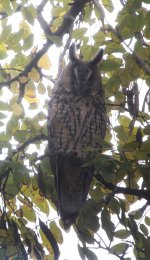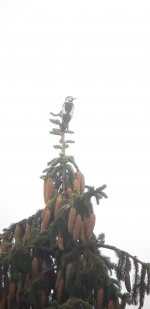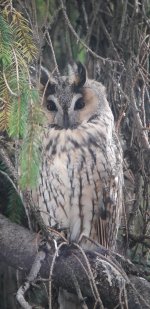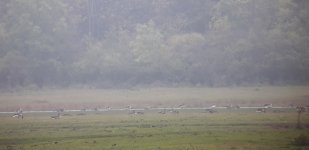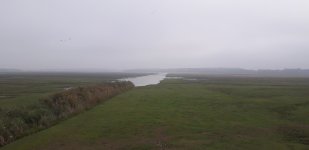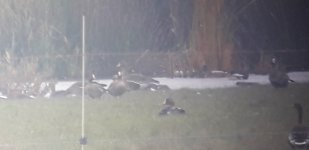dwatsonbirder
Well-known member
Day One (22.10.22)
Each October myself and a few friends take a few days off for birding, normally somewhere along the east coast of the UK. With travel once again opening up, Johny suggested a trip to the Hortobagyi area of Hungary as an alternative. Time was very much of the essence this year, with Johny and Gareth staying on for a week (still there at the time of writing, and providing regular grippage via whatsapp), whilst John and I could only commit to four days.
After a very early start in time for our 06:30 flight from Stansted to Budapest, we landed around 08:30 ahead of a whistle-stop birding trip around eastern Hungary. The first birds of the trip were Skylark, Crested lark, Hooded Crow and Tree sparrow, with all four species becoming more or less ubiquitous throughout our trip. Common buzzard was also very frequent, whilst an early highlight just outside of the city was a smart Great grey shrike perched up on roadside wires.
Having negotiated the airport and sorted the hire car, we decided that our first stop would be the area of rather homogeneous farmland between Bugyi and Dabas just south of Budapest. This area has become a rather good area in recent times for geese, with the outside chance of Great Bustard too. Sadly, the latter species eluded John and I during our four days, the only blip in an otherwise enjoyable trip.
We parked at a little pull at Borzasi zsilip, and walked south east along the track to search the farmland. Having barely stepped out of the car, Gareth called a woodpecker flying out of a reedy ditch - a lovely Lesser-spotted Woodpecker. A quick scan revealed several raptors in rather quick succession; White-tailed eagle, Kestrel, Sparrowhawk and two ringtail Hen harriers in addition to several Buzzard. We walked along the track, picking up more birds as we went, with a particularly strong showing of raptors - we soon added Merlin, a rather late Hobby and an early highlight in the form of an immature Eastern Imperial eagle. A little later on, we would watch a young Goshawk hunting feral pigeon, making for a pretty standout showing of nine raptor species from a rather random bit of farmland - not bad. We also heard Penduline tit calling from two areas - one over near the fishing ponds, and a bird calling from the reedbed near to the car park.
Unfortunately we couldn’t find any geese, and there was no sign of any bustard, so we decided to continue east towards our base just outside of Hajdúszoboszló, a few hours later than planned.
Travelling east along the E60 towards Szolnok, we encountered further raptors, with two adult and an immature Eastern Imperial eagle atop the roadside pylons, in addition to one of our most wanted species - Saker. Also seen along the journey was our first Rough-legged buzzard, as well as a distant bird which was probably Long-legged buzzard, unfortunately a bit too brief and distant to pin down.
Our final stops of the day were along the road that borders the national park as you head north towards Nádudvar, where we started to encounter our first larger groups of Common Crane. A stop at a pig farm (of all places!) south west of the farm delivered a bonus Woodcock, along with a precursory showing of small groups of Common Crane heading off to roost. A brief call sounded spot on for Spotted crake, however after stealthily tracking the bird for 5 minutes or so, the source of the “call” was found to be a leaky pipe attached to a timer… it had been a long day!
At our accommodation we scrambled some form of vegetable pasta dinner together, sank a few beers and retired to bed around half 9. Gareth added Tawny and Little Owl to proceedings whilst enjoying a post dinner smoke, however half of our number (me included) had already retired by this point.
Each October myself and a few friends take a few days off for birding, normally somewhere along the east coast of the UK. With travel once again opening up, Johny suggested a trip to the Hortobagyi area of Hungary as an alternative. Time was very much of the essence this year, with Johny and Gareth staying on for a week (still there at the time of writing, and providing regular grippage via whatsapp), whilst John and I could only commit to four days.
After a very early start in time for our 06:30 flight from Stansted to Budapest, we landed around 08:30 ahead of a whistle-stop birding trip around eastern Hungary. The first birds of the trip were Skylark, Crested lark, Hooded Crow and Tree sparrow, with all four species becoming more or less ubiquitous throughout our trip. Common buzzard was also very frequent, whilst an early highlight just outside of the city was a smart Great grey shrike perched up on roadside wires.
Having negotiated the airport and sorted the hire car, we decided that our first stop would be the area of rather homogeneous farmland between Bugyi and Dabas just south of Budapest. This area has become a rather good area in recent times for geese, with the outside chance of Great Bustard too. Sadly, the latter species eluded John and I during our four days, the only blip in an otherwise enjoyable trip.
We parked at a little pull at Borzasi zsilip, and walked south east along the track to search the farmland. Having barely stepped out of the car, Gareth called a woodpecker flying out of a reedy ditch - a lovely Lesser-spotted Woodpecker. A quick scan revealed several raptors in rather quick succession; White-tailed eagle, Kestrel, Sparrowhawk and two ringtail Hen harriers in addition to several Buzzard. We walked along the track, picking up more birds as we went, with a particularly strong showing of raptors - we soon added Merlin, a rather late Hobby and an early highlight in the form of an immature Eastern Imperial eagle. A little later on, we would watch a young Goshawk hunting feral pigeon, making for a pretty standout showing of nine raptor species from a rather random bit of farmland - not bad. We also heard Penduline tit calling from two areas - one over near the fishing ponds, and a bird calling from the reedbed near to the car park.
Unfortunately we couldn’t find any geese, and there was no sign of any bustard, so we decided to continue east towards our base just outside of Hajdúszoboszló, a few hours later than planned.
Travelling east along the E60 towards Szolnok, we encountered further raptors, with two adult and an immature Eastern Imperial eagle atop the roadside pylons, in addition to one of our most wanted species - Saker. Also seen along the journey was our first Rough-legged buzzard, as well as a distant bird which was probably Long-legged buzzard, unfortunately a bit too brief and distant to pin down.
Our final stops of the day were along the road that borders the national park as you head north towards Nádudvar, where we started to encounter our first larger groups of Common Crane. A stop at a pig farm (of all places!) south west of the farm delivered a bonus Woodcock, along with a precursory showing of small groups of Common Crane heading off to roost. A brief call sounded spot on for Spotted crake, however after stealthily tracking the bird for 5 minutes or so, the source of the “call” was found to be a leaky pipe attached to a timer… it had been a long day!
At our accommodation we scrambled some form of vegetable pasta dinner together, sank a few beers and retired to bed around half 9. Gareth added Tawny and Little Owl to proceedings whilst enjoying a post dinner smoke, however half of our number (me included) had already retired by this point.
Last edited:





